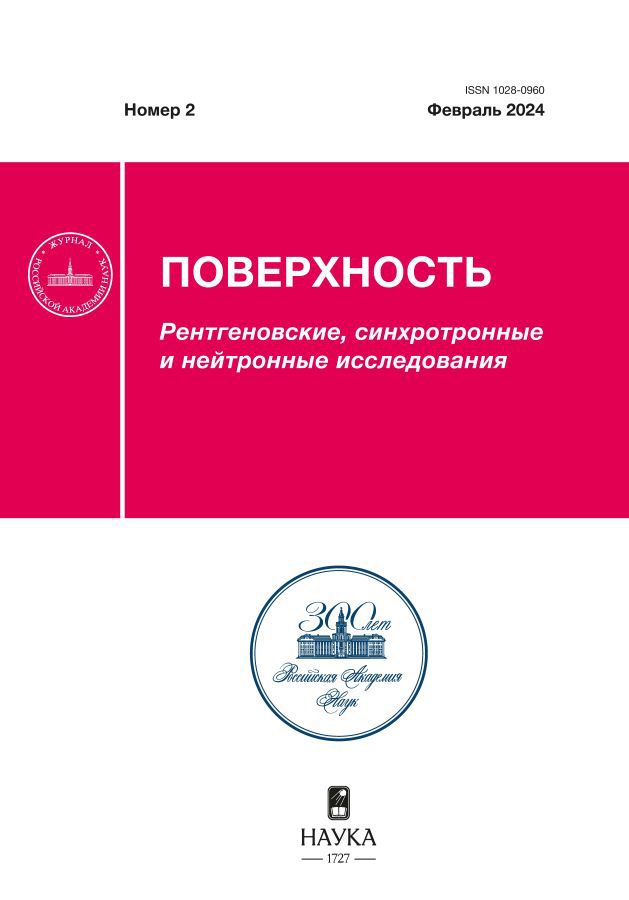Towards to Theory of the X-ray Diffraction Tomography of Crystals with Nano-Sized Defects
- Autores: Grigorev V.A.1, Konarev P.V.1, Chukhovskii F.N.1, Volkov V.V.1
-
Afiliações:
- Shubnikov Institute of Crystallography, FSRC “Crystallography and Photonics” of the RAS
- Edição: Nº 2 (2024)
- Páginas: 68-73
- Seção: Articles
- URL: https://archivog.com/1028-0960/article/view/664780
- DOI: https://doi.org/10.31857/S1028096024020102
- EDN: https://elibrary.ru/AYBPMA
- ID: 664780
Citar
Texto integral
Resumo
X-ray diffraction tomography is an innovative method that is widely used to obtain 2D-phase-contrast diffraction images and their subsequent 3D-reconstruction of structural defects in crystals. The most frequent objects of research are linear and helical dislocations in a crystal, for which plane wave diffraction images are the most informative, since they do not contain additional interference artifacts unrelated to the images of the defects themselves. In this work the results of modeling and analysis of 2D plane wave diffraction images of a nano-dimensional Coulomb-type defect in a Si(111) thin crystal are presented based on the construction of numerical solutions of the dynamic Takagi-Taupin equations. An adapted physical expression for the elastic displacement field of the point defect, which excludes singularity at the defect location in the crystal, is used. A criterion for evaluating the accuracy of numerical solutions of the Takagi-Taupin equations is proposed and used in calculations. It is shown that in the case of the Coulomb-type defect elastic displacement field, out of the two difference algorithms for solving the Takagi-Taupin equations used in their numerical solution, only the algorithm for solving the Takagi-Taupin equations where the displacement field function enters in exponential form is acceptable in terms of the required accuracy-duration of the calculations.
Sobre autores
V. Grigorev
Shubnikov Institute of Crystallography, FSRC “Crystallography and Photonics” of the RAS
Autor responsável pela correspondência
Email: vasiliy.grigorev.1996@mail.ru
Rússia, Moscow
P. Konarev
Shubnikov Institute of Crystallography, FSRC “Crystallography and Photonics” of the RAS
Email: vasiliy.grigorev.1996@mail.ru
Rússia, Moscow
F. Chukhovskii
Shubnikov Institute of Crystallography, FSRC “Crystallography and Photonics” of the RAS
Email: vasiliy.grigorev.1996@mail.ru
Rússia, Moscow
V. Volkov
Shubnikov Institute of Crystallography, FSRC “Crystallography and Photonics” of the RAS
Email: vasiliy.grigorev.1996@mail.ru
Rússia, Moscow
Bibliografia
- Шульпина И.Л., Суворов Э.В., Смирнова И.А., Аргунова Т.С. // Журнал технической физики. 2022. Т. 92. № 10. С. 1475. https://www.doi.org/10.21883/JTF.2022.10.53240.23-22
- Золотов Д.А., Асадчиков В.Е., Бузмаков А.В., Волков В.В., Дьячкова И.Г., Конарев П.В., Григорьев В.А., Суворов Э.В. https://www.doi.org/10.3367/UFNr.2022.05.039199.
- Takagi S. // Acta Cryst. 1962. V. 15. P. 1311. https://www.doi.org/10.1107/S0365110X62003473
- Takagi S. // J. Phys. Soc. Jpn. 1969. V. 26. № 5. P. 1239. https://www.doi.org/10.1143/JPSJ.26.1239
- Taupin D. // Bulletin de la Société française de Minéralogie et de Cristallographie. 1964. V. 87. № 4. P. 469. https://doi.org/10.3406/bulmi.1964.5769
- Mocella V., Lee W.-K., Tajiri G., Mills D., Ferrero C., Epelboin Y. // J. Appl. Cryst. 2003. V. 36. P. 129. https://www.doi.org/10.1107/S0021889802020526
- Epelboin Y., Ribet M. // Phys. Stat. Solidi A. 1974. V. 25. P. 507. https://www.doi.org/10.1002/pssa.2210250217
- Epelboin Y. // Mater. Sci. Engineer. 1985. V. 73. P. 1. https://www.doi.org/10.1016/0025-5416(85)90294-0
- Holy V. // Phys. Stat. Solidi B. 1982. V. 111. P. 341. https://www.doi.org/10.1002/pssb.2221110139
- Holy V. // Phys. Stat. Solidi B. 1982. V. 112. P. 161. https://www.doi.org/10.1002/pssb.2221120118
- Besedin I.S., Chukhovskii F.N., Asadchikov V.E. // Cryst. Rep. 2014. V. 59. P. 323. https://www.doi.org/10.1121/1.5138606
- Asadchikov V., Buzmakov A., Chukhovskii F., Dyachkova I., Zolotov D., Danilewsky A., Baumbach T., Bode S., Haaga S., Hänschke D., Kabukcuoglu M., Balzer M., Caselle M., Suvorov E. // J. Appl. Cryst. 2018. V. 51. P. 1616. https://www.doi.org/10.1107/S160057671801419X
- Золотов Д.А., Асадчиков В.Е., Бузмаков А.В., Дьячкова И.Г., Суворов Э.В. // ЖЭТФ. 2021. Т. 113. № 3. С. 161. https://www.doi.org/10.31857/S1234567821030046
- Reischig P., King A., Nervo. L., Vigano N., Guilhem Y., Palenstijn. W.J., Batenburg K.J., Preussdand M., Ludwig W. // J. Appl. Cryst. 2013. V. 46. P. 297. https://www.doi.org/10.1107/S0021889813002604
- Chukhovskii F.N., Konarev P.V., Volkov V.V. // Sci. Rep. 2019. V. 9. № 14216.
- Chukhovskii F.N., Konarev P.V., Volkov V.V. // Cryst. Rep. 2019. V. 64. № 2. https://www.doi.org/10.1134/S1063774519020172
- Chukhovskii F.N., Konarev P.V., Volkov V.V. // Acta Cryst. A. 2020. V. 76. P. 163. https://www.doi.org/10.1107/S2053273320000145
- Lei Z., Okunev A., Zhu C., Verozubova G., Yang C. // J. Crystal Growth. 2020. V. 534. № 125487. https://www.doi.org/10.1016/j.jcrysgro.2020.125487
- Lei Z., Okunev A., Zhu C., Verozubova G., Yang C. // J. Appl. Cryst. 2018. V. 51. P. 361.
- Кривоглаз М.А. Дифракция рентгеновских лучей и нейтронов в неидеальных кристаллах. Киев: Наукова думка, 1983. 408 с.
Arquivos suplementares















